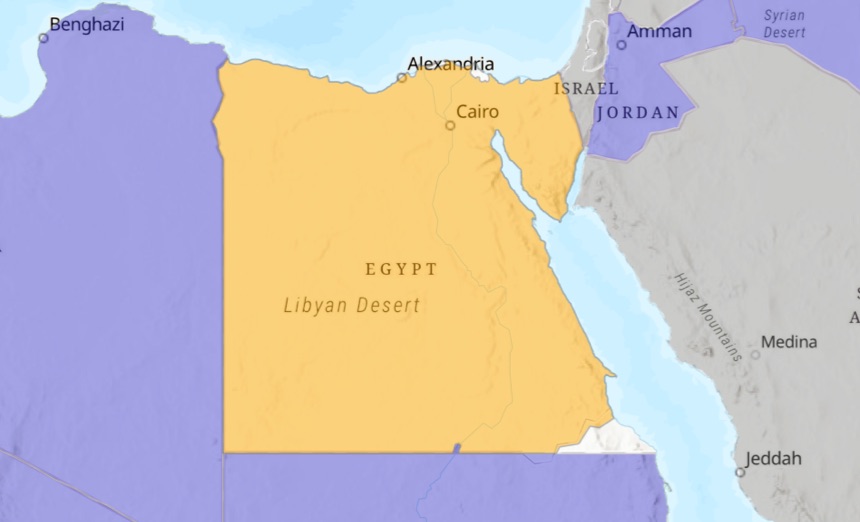Since the 2011 uprising, Egypt has experienced an increase in political instability, an escalation of violence and the widespread proliferation of small arms and light weapons – mostly those looted from police stations during the uprising.1 Large amounts of weapons were also reportedly smuggled to and through Egypt from neighbouring Libya regularly after 2011.2 At the same time, the country became progressively involved in a non-international armed conflict against the non-state armed group Wilayat Sinai, which has pledged loyalty to the Islamic State.3
In terms of weapons and ammunition management, the national regulation on weapons possession is considered restrictive and the country is not party to the principal international treaties and protocols on weapons and ammunition.4
1 Mohamed Elmeshad, “Smuggled, Stolen and Homemade, Guns Flood Egypt’s streets,” Egypt Independent, June 27, 2011, https://www.egyptindependent.com/smuggled-stolen-and-homemade-guns-flood-egypts-streets/.
2 "Final Report of the Panel of Experts Established Pursuant to Resolution 1973 (2011) Concerning Libya," UN Security Council, S/2013/99, March 9, 2013, https://documents-dds-ny.un.org/doc/UNDOC/GEN/N13/254/43/PDF/N1325443.pdf?OpenElement.
3 Annabel Bassil, The War Report: Non-International Armed Conflict to Continue in Sinai? (Geneva: Geneva Academy, 2019), https://www.geneva-academy.ch/joomlatools-files/docman-files/Non-International%20Armed%20Conflict%20To%20Continue%20In%20Sinai%20.pdf.
4 Philip Alpers and Marcus Wilson, Egypt – Gun Facts, Figures and the Law (GunPolicy.org, Sydney School of Public Health, University of Sydney, 2022), https://www.gunpolicy.org/firearms/region/egypt.
Launch the country dashboard
Further information
Accidental explosions
Since the Small Arms Survey began collecting data in 1979, three accidental explosions have been reported in Egypt.
Table 1. Accidental explosions in Egypt (1979–2021)
Year | Location | Owner/manager | Deaths | Injuries |
2013 | Asyut | State (military) | 2 | 14 |
2009 | Ismailia | State (military) | 0 | N/A |
1987 | Alexandria | State (military) | 6 | 1,000 |
Source: “Unplanned Explosions at Munitions Sites (UEMS) Database,” Small Arms Survey, updated December 15, 2021, https://smallarmssurvey.org/database/unplanned-explosions-munitions-sites-uems.
Cases of diversion
Several cases of diversion have been reported in Egypt.
Table 2. Cases of diversion of arms, ammunition and explosives in Egypt
Year | Location | Description |
2015 | El Qantara | The Ismailia’s governorate prosecution ordered the detention of two police officers who had allegedly stolen three mechanical rifles, a 9 mm machine gun, a birdshot rifle and 41 bullets.1 |
2011 | Cairo | The North Cairo Criminal Court accused two people of stealing military firearms (number and characteristics unspecified) from the military during the Maspero Massacre.2 |
1 “Two Egyptian Policemen Detained for Stealing Weapons, Cars from Evidence,” Ahram Online, June 14, 2015, https://english.ahram.org.eg/NewsContentP/1/132783/Egypt/Two-Egyptian-policemen-detained-for-stealing-weapo.aspx.
2 Hend Kortam, “Two Copts Convicted of Stealing Weapons during Maspero Massacre,” Daily News Egypt, February 4, 2013, https://dailynewsegypt.com/2013/02/04/two-copts-convicted-of-stealing-weapons-during-maspero-massacre/.
Disposal
Insufficient information on the disposal of ammunition in Egypt.
Needs
No needs have been reported for Egypt.
Source: Egypt, National Report on the Implementation of the Programme of Action on Small Arms and Light Weapons (PoA) and the International Tracing Instrument (ITI) (New York: Permanent Mission of Egypt to the UN, 2022).



